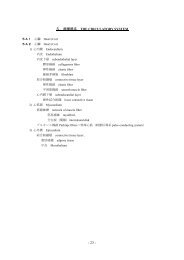Program / Abstract Book - KMU WWW3 Server for Education ...
Program / Abstract Book - KMU WWW3 Server for Education ...
Program / Abstract Book - KMU WWW3 Server for Education ...
You also want an ePaper? Increase the reach of your titles
YUMPU automatically turns print PDFs into web optimized ePapers that Google loves.
No. 58 (PM 7)<br />
Mycobacterium Kyorinense Infection: Clinical Features and Antimicrobial<br />
Susceptibility<br />
Hiroaki Ohnishi 1 , Shota Yonetani 1 , Satsuki Matsushima 1 , Kouki Ohtsuka 1 , Tomonori<br />
Kishino 1 , Hiroo Wada 2 , Hajime Goto 2 , Takashi Watanabe 1<br />
Departments of 1 Laboratory Medicine and 2 Respiratory Medicine, Kyorin University<br />
School of Medicine, Japan<br />
Mycobacterium kyorinense is a nonpigmented, slowly growing mycobacterium that was initially<br />
isolated in 2007. Biochemical tests and genetic analyses showed that M. kyorinense is most closely<br />
related to M. celatum and M. branderi. We here describe 7 newly identified cases with 4 previously<br />
reported cases, in which infection potentially was caused by M. kyorinense. In reviewing these 11 cases<br />
(10 Japanese and 1 Brazilian), 9 presented with respiratory infections, 1 with lymphadenitis, and 1 with<br />
arthritis. Seven patients were treated by first-line tuberculosis drugs, mainly consisting of rifampin,<br />
isoniazid, and ethambutol, but these therapies were ineffective in all cases. Six cases were treated with a<br />
combination of antibiotics including macrolides and fluoroquinolones as a first- or second-line<br />
chemotherapy, and infection was subdued without recurrence in 5 cases. In contrast, 4 pneumonia<br />
patients who did not receive sufficient therapy with the latter regimen eventually died of infection. In<br />
concordance with the clinical antimicrobial susceptibility, most strains exhibited relatively high MICs<br />
<strong>for</strong> rifampin, ethambutol, and isoniazid, and relatively low MICs <strong>for</strong> macrolides, aminoglycosides, and<br />
quinolones. Notably, remarkably high MICs (>32 �g/ml) w<br />
Direct sequencing of the 16S rRNA gene revealed that all available M. kyorinense isolates were<br />
identical within this gene, except <strong>for</strong> the Brazilian strain which showed slight difference with other<br />
Japanese isolates. Direct sequencing of the entire rpoB gene demonstrated that all strains had identical<br />
sequences, with Ser531 in the M. tuberculosis RpoB protein replaced by an Asp in M. kyorinense.<br />
Notably, Ser531 is the most frequent location of substitutions in rifampin-resistant strains of M.<br />
tuberculosis. These data suggest that M. kyorinense belongs to non-tuberculous mycobacteria that have<br />
pathogenicity <strong>for</strong> humans with substantial clinical significance, and that M. kyorinense is inherently<br />
resistant to rifampin due to the structural features of its RpoB protein.<br />
- 111 -



